bahan nano








Nanomaterial berbasis boron muncul sebagai bahan elektrokatalis (foto) yang tidak beracun dan berlimpah di bumi dalam konversi energi matahari untuk produksi bahan bakar hidrogen surya dan perbaikan lingkungan. Boron carbon oxynitride (BCNO) adalah semikonduktor kuaterner dengan sifat elektronik, optik, dan fisikokimia yang dapat disetel dengan memvariasikan komposisi boron, nitrogen, karbon, dan oksigen. Namun, hubungan antara struktur BCNO dan hubungan aktivitas fotokatalitik belum dieksplorasi. Kami melakukan analisis spektroskopi mendalam untuk menjelaskan efek penggunaan dua prekursor nitrogen yang berbeda dan efek suhu anil dalam pembuatan BCNO. BCNO nanodisk (D = 6.7 ± 1.1 nm) dengan pola difraksi boron nitrida turbostratik dibuat menggunakan guanidin hidroklorida sebagai prekursor sumber nitrogen pada anil termal pada 800 °C. Analisis elemen permukaan spektroskopi fotoelektron sinar-X (XPS) dari nanodisk BCNO mengungkapkan komposisi B, C, N, dan O masing-masing menjadi 40,6%, 7,95%, 37,7%, dan 13,8%. Menurut solid-state 11 Analisis B NMR, nanodisk BCNO yang diturunkan dari guanidin hidroklorida menunjukkan pembentukan berbagai trikoordinat BNx (OH)3−x spesies, yang juga berfungsi sebagai salah satu situs aktif fotokatalitik. XRD dan analisis spektroskopi mendalam menguatkan persiapan nanodisk boron nitrida heksagonal yang didoping BCNO. Sebaliknya, BCNO yang dianil pada 600 °C menggunakan melamin sebagai prekursor nitrogen terdiri dari nanosheet berlapis yang terdiri dari atom B, C, N, dan O yang terikat secara kovalen dalam kisi sarang lebah sebagai bukti oleh XRD, XPS, dan NMR solid-state analisis ( 11 B dan 13 C) analisis. Komposisi unsur permukaan XPS dari struktur berlapis BCNO turunan melamin terdiri dari komposisi karbon tinggi (75,1%) dengan komposisi boron yang relatif rendah (5,24%) dan nitrogen (7,27%), yang mengindikasikan pembentukan oksida graphene yang didoping BCNO struktur lembaran berlapis. Rangkaian struktur berlapis graphene oxide yang diturunkan dari melamin yang diturunkan dari BCNO ini ditemukan menunjukkan aktivitas fotokatalitik tertinggi, melebihi aktivitas fotokatalitik karbon nitrida grafit. Dalam struktur berlapis ini, pembentukan BN tetrakoordinatx (OH)3−x (CO) spesies dan domain grafit yang kaya diusulkan untuk memainkan peran penting dalam aktivitas fotokatalitik dari struktur berlapis graphene oxides yang didoping BCNO. Energi celah pita optik masing-masing diukur menjadi 5,7 eV dan 4,2 eV untuk nanodisk boron nitrida heksagonal yang didoping BCNO dan struktur berlapis graphene oksida yang didoping BCNO. Akhirnya, BCNO menunjukkan photoluminescence ultralong dengan masa peluruhan rata-rata 1,58, 2,10, 5,18, dan 8,14 s untuk BGH01, BGH03, BMH01, BMH03, masing-masing. Studi ini memberikan sistem fotokatalitik bebas logam baru dan memberikan analisis struktural pertama mengenai asal usul fotokatalis berbasis BCNO.
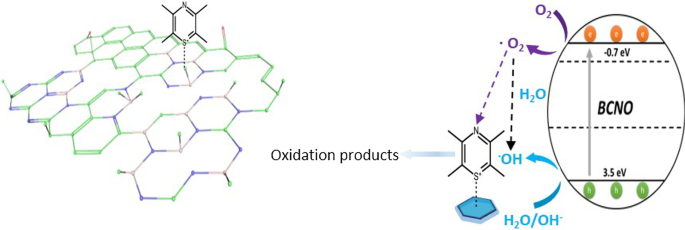
Nanomaterial bebas logam muncul sebagai katalis (foto) yang hemat biaya dan ramah lingkungan dengan stabilitas struktural dan kimia yang tinggi untuk berbagai aplikasi termasuk produksi bahan bakar surya, remediasi lingkungan, CO2 pengurangan, desinfeksi mikroorganisme berbahaya, dan memungkinkan sintesis kimia selektif senyawa organik [1,2,3,4,5,6,7]. Dibandingkan dengan rekan-rekan logam mereka, katalis bebas logam juga kurang rentan terhadap keracunan dan menyebabkan siklus hidup yang lebih tinggi. Oleh karena itu, pencarian dan pengembangan material baru yang stabil, efisien, dan hemat biaya tetap merupakan upaya penelitian yang kritis dan menantang. Material berbasis karbon seperti graphitic carbon nitride (CN) [4, 8, 9], carbon-dot (C-dot) [2, 3, 10], dan material berbasis graphene [7, 11] telah banyak diteliti. karena sifat fisikokimia yang sangat baik, stabilitas struktural dan kimia, dan kemudahan sintesis dari unsur-unsur yang melimpah di bumi. Baru-baru ini, katalis (foto) berbasis boron telah dikembangkan sebagai sistem fotokatalitik bebas logam dengan kinerja yang luar biasa. Khususnya, boron karbida, yang dikenal karena kekerasannya, menunjukkan generasi hidrogen fotokatalitik cahaya tampak bebas logam, melebihi fotokatalis CN berbasis karbon yang canggih [12, 13]. Lembar nano heksagonal boron nitrida (BCN) yang didoping karbon dengan luas permukaan tinggi yang menunjukkan aktivitas fotokatalitik cahaya tampak untuk H2 danO2 pembangkitan serta CO2 reduksi dan penangkapan telah menghasilkan kemungkinan baru dalam fotosistem [14, 15]. Elektrokatalis (foto) yang mengandung boron lainnya seperti boron oxynitride (BNO)[16, 17], boron phosphide (BP) [18, 19], graphene doped boron [20], boron karbon nitrida (BCN) [14], karbon nitrida yang didoping boron (B-dopedCN ) [21] dan unsur boron [22, 23] telah menunjukkan aktivitas elektrokatalitik (foto) yang signifikan [13].
Boron carbon oxynitride (BCNO) adalah bahan nano berbasis boron yang telah dipelajari lebih sedikit daripada bahan lainnya. Ini pertama kali dikembangkan setelah pendahulunya BCN, semikonduktor dengan celah pita sekitar 2 eV, untuk menggantikan fosfor beracun berdasarkan senyawa oksinitrida dan nitrida [24, 25]. Substitusi atom B, C, O dan N ke dalam jaringan graphene atau boron nitrida heksagonal (hBN) memunculkan senyawa BCNO dengan sifat photoluminescence yang dapat disetel dan celah pita mulai dari 0 eV (graphene) hingga 5,9 eV (hBN) [26] . Sifat semikonduktor dan fotoluminesensi yang diinginkan ini baru-baru ini menarik para peneliti untuk mengembangkan metodologi sintetis baru untuk mensintesis struktur nano BCNO dimensi rendah dengan kristalinitas yang lebih tinggi [27], bentuk terkontrol [28], dan dalam struktur 2D yang tipis secara atomik [29]. Karya sebelumnya menyelidiki efek suhu anil dan waktu dalam memodulasi properti photoluminescence BCNO tanpa memberikan karakterisasi struktural yang mendalam [30, 31]. Dalam makalah ini, kami menyelidiki pengaruh penggunaan prekursor sumber nitrogen yang berbeda, suhu kalsinasi (800 °C vs. 600C), dan waktu kalsinasi (0,5 jam vs. 12 jam) pada aktivitas struktur-fotokatalitik struktur nano BCNO.
Asam borat 99,99% (H3 BO3 ), melamin 99% (C3 H6 N6 ), dan heksametilenatetramina ≥ 99% (C6 H12 N4 ) dibeli dari Alfa Aesar dan digunakan tanpa pemurnian lebih lanjut. Guanidine hidroklorida 99,5% (CH5 N3 HCl) dibeli dari Arcos Organics. BCNO disintesis menurut literatur melalui metode anil suhu rendah [25, 32]. Analisis UPS dilakukan dalam ULVAC-PHI PHI 5000 Versaprobe II menggunakan He I 21,22 eV sebagai sumber foton dengan bias 5 V. Morfologi sampel BCNO dianalisis melalui mikroskop elektron transmisi (JEOL, JEM-ARM200FTH). Difraksi XRD diperoleh dengan menggunakan spektrometer Bruker D2. Spektrum emisi fotoluminesensi dalam larutan diperoleh dengan menggunakan spektrometer fotoluminesensi (PerkinElmer, LS55), dan spektrum serapan optik BCNO dalam larutan ditentukan dengan spektrometer UV-Vis (HITACHI, U-3900). Spektroskopi fotoelektron sinar-X dianalisis melalui spektrometer fotoelektron sinar-X resolusi tinggi (ULVAC-PHI, PHI Quantera II) menggunakan sinar-x Al Ka sebagai sumber eksitasi. Solusi BCNO dijatuhkan ke substrat silikon untuk karakterisasi XPS. Energi ikat dikalibrasi menjadi karbon pada 284,8 eV. Dekonvolusi dan pemasangan puncak XPS dilakukan menggunakan perangkat lunak CACS XPS. PLQY mutlak dilakukan menurut literatur [33] dan dideteksi oleh kamera CCD (PIXIS 256BR, Princeton Instruments). Pengukuran PLQY absolut dilakukan dengan menggunakan spektrograf berbasis serat, termasuk sistem bola terintegrasi yang dikalibrasi (Labsphere) dan kamera charge-coupled device (CCD) (PIXIS 256BR, Princeton Instruments). Laser dioda (λ = 375 nm, Becker &Hickl GmbH) digunakan sebagai sumber pemompaan. Fotoluminesensi yang diselesaikan dengan waktu diukur dalam konfigurasi muka depan dengan menggunakan laser nitrogen berdenyut (λ = 337.1 nm, LTB Lasertechnik Berlin GmbH) sebagai sumber eksitasi, yang dipicu oleh generator penundaan digital (DG645, Stanford Research Systems). Sinyal dideteksi oleh tabung photomultiplier penghitung foton (PMC-100-1, Becker &Hickl GmbH), dan jumlah foton diakumulasikan dengan modul multiscaler (MSA-300, Becker &Hickl GmbH). Spektrum inframerah direkam dengan spektrometer inframerah transformasi Fourier (Bruker, Vertex 80v) menggunakan Attenuated Total Reflectance (ATR). Spektrum resonansi magnetik nuklir diperoleh dengan menggunakan spektrometer Bruker Avance III 400 NMR yang dilengkapi dengan magnet 9,4 T menggunakan probe magic angle spinning (MAS) 4 mm. 11 B MAS NMR direkam menggunakan metode spin echo dengan kecepatan putaran 10 kHz. 8000 pindaian dikumpulkan dengan penundaan daur ulang 4 detik. Pergeseran kimia dirujuk ke 1 M H3 BO3 larutan berair pada 19,6 ppm. 13 Spektrum C CP/MAS NMR direkam menggunakan urutan polarisasi silang (CP) dengan kecepatan putaran 12,5 kHz. 30.000 pindaian dikumpulkan dengan penundaan daur ulang 4 detik. Semua 13 Pergeseran kimia C direferensikan ke trimetilsilana rapi menggunakan referensi sekunder adamantane CH2 puncaknya pada 38,48 ppm.
Dalam penelitian ini, dua seri BCNO dibuat menggunakan dua sumber prekursor nitrogen yang berbeda sambil memperbaiki sumber prekursor boron dan karbon, rasio prekursor, suhu annealing, dan waktu. Pengaruh suhu dan waktu anil juga diselidiki dengan menetapkan semua parameter reaksi lain untuk setiap seri BCNO yang disiapkan dalam penelitian ini. Secara singkat, ketiga komponen prekursor dalam rasio mol yang telah ditentukan ditambahkan ke air suling dan dipanaskan sampai 90 °C sampai larutan tampak homogen (Tabel 1). Campuran ketan dikeringkan dalam oven semalaman, menghasilkan padatan putih kering. Padatan putih digerus menggunakan mortar dan alu hingga menjadi serbuk halus. Prekursor padat dikalsinasi dalam tungku pada suhu dan waktu yang telah ditentukan, seperti yang ditunjukkan pada Tabel 1, dengan laju ramping 5 °C/menit di bawah tekanan atmosfer sekitar. Sampel bubuk berwarna kekuningan digiling menjadi bubuk halus setelah tungku didinginkan secara alami hingga suhu kamar.
BCNO yang telah disiapkan dimurnikan dengan sentrifugasi pada 6000 rpm selama 10 menit dalam air dan etanol (1:10 v/v dalam konsentrasi 10 mg/mL). Setelah sentrifugasi, produk dilarutkan kembali dalam air suling, diencerkan dengan etanol dalam rasio 1:10 v/v air:etanol. BCNO yang dimurnikan diendapkan ke dalam kisi tembaga berlapis karbon untuk analisis TEM. Untuk preparasi spesimen SEM dan XPS, sampel BCNO yang telah dimurnikan diteteskan ke wafer silikon. Sebelum deposisi sampel, wafer silikon dibersihkan dengan sonikasi dengan air, propanol, dan aseton selama 10 menit dalam setiap pelarut. Spesimen UPS disiapkan dengan cara yang mirip dengan prosedur yang dijelaskan untuk sampel SEM dan XPS, kecuali bahwa sampel disimpan ke dalam kaca berlapis indium tin oxide (ITO).
CN massal disintesis dengan metode lancar yang dilaporkan dalam literatur [34]. Secara singkat, bubuk melamin ditempatkan ke dalam wadah dan dianil pada suhu 550℃ selama empat jam dengan laju peningkatan 5 /menit di bawah tekanan atmosfer sekitar.
Aktivitas fotokatalitik dari berbagai sampel BCNO dievaluasi melalui fotodegradasi metilen biru (MB) sebagai model reaksi. Dalam eksperimen degradasi pewarna biasa, 10 mg sampel BCNO ditambahkan ke dalam botol sampel yang berisi 15 mL larutan MB (10 ppm). Setelah diaduk selama 10 menit dalam gelap, botol sampel diiradiasi dengan lampu Xenon 100 W (250 nm ~ 1100 nm). Sampel kinetik (2 mL) diekstraksi menggunakan pipet dari larutan pada interval waktu 20 menit hingga total waktu degradasi fotokatalitik mencapai 80 menit. Sampel kinetik pada interval waktu yang berbeda dianalisis melalui spektrometer UV-vis. Perubahan konsentrasi MB diturunkan menggunakan hukum Beer.
Dalam penelitian kami untuk persiapan struktur nano BCNO dimensi rendah dengan kristalinitas tinggi untuk memfasilitasi pengangkutan muatan, kami menemukan BCNO dengan struktur kimia dan aktivitas fotokatalitik yang sangat berbeda. Berdasarkan sintesis BCNO yang dilaporkan dalam literatur [25, 32], kami menyelidiki efek penggunaan dua sumber prekursor nitrogen yang berbeda serta efek suhu anil termal, dan waktu pada evolusi struktur-properti BCNO. Dalam penelitian ini, dua seri BCNO dibuat masing-masing menggunakan asam borat dan heksametilenatetramina sebagai sumber boron dan karbon (Tabel 1). BCNO disintesis menggunakan melamin dan guanidin hidroklorida sebagai sumber nitrogen dan masing-masing dilambangkan sebagai BMH dan BGH. Setelah secara sistematis menyelidiki setiap kondisi reaksi, rangkaian BMH hanya menunjukkan aktivitas fotokatalitik ketika dianil pada suhu 600 °C yang lebih rendah selama 12 jam. Seri BGH hanya menunjukkan aktivitas fotokatalitik dengan anil suhu tinggi pada 800 °C selama 12 jam. Pada kedua seri, rasio mol asam borat, melamin, dan guanidin hidroklorida ditetapkan pada 3:1, sedangkan rasio mol heksametilenatetramina bervariasi dari 0,1 hingga 0,3. Rasio prekursor heksametilenatetramina ini masing-masing dilambangkan dalam nama sampel sebagai BMHH01/BGH01 dan BMH03/BGH03 (Tabel 1).
Gambar 1 menunjukkan gambar TEM representatif dari BGH yang dikalsinasi pada 800 °C selama 12 jam yang terdiri dari inti kristal dengan morfologi nanopartikel kuasi-sferis dan D = 6.7 ± 1 nm. BGH yang telah disiapkan siap didispersikan dalam air (File tambahan 1:Gbr. S1), dan sebagaimana dibuktikan oleh deposisi nanopartikel diskrit pada jaringan tembaga TEM. Dispersi BGH dan BMH dalam air kemungkinan besar berasal dari stabilisasi elektrostatik berdasarkan potensial permukaan BGH dan BMH yang bermuatan negatif. Kondisi padat 11 Analisis B NMR mengungkapkan bahwa banyaknya gugus hidroksil dalam struktur nano BMH dan BGH menguatkan dispersibilitasnya dalam media berair. Di bawah pembesaran tinggi, setiap nanopartikel kuasi-sferis menunjukkan jarak kisi yang berbeda dari bidang (002) yang diukur menjadi 0,338 nm, yang konsisten dengan laporan literatur [24, 35] (Gbr. 1c). Dibandingkan dengan nanopartikel BCNO 5 nm yang diperoleh melalui anil termal di lingkungan garam eutektik, nanopartikel BGH yang disiapkan dalam penelitian ini memiliki kristalinitas tinggi [25] (Gbr. 1). Selanjutnya, kami mengkarakterisasi BMH yang dibuat berdasarkan laporan literatur menggunakan asam borat, melamin, dan heksametilenatetramina dan dianil pada 600 °C selama 12 jam. Berbeda dengan morfologi BGH, BMH terdiri dari lembaran berlapis-lapis dengan bentuk yang tidak jelas (Gbr. 1). Pada perbesaran yang lebih tinggi, gambar TEM dari tepi pada lembaran multilayer (Gbr. 1d) mengungkapkan lembaran nano dengan fitur distorsi struktural [36] seperti yang ditunjukkan pada Gambar. 1e. Gambar 1f menunjukkan gambar SEM representatif dari BMH termasuk agregat berukuran mikron tanpa fitur. Namun, tidak seperti seri BGH, kalsinasi suhu yang lebih tinggi pada 800 °C menggunakan melamin sebagai prekursor sumber nitrogen tidak menghasilkan morfologi nanodisk. TEM, XRD, absorbansi UV, dan fotoluminesensi dari senyawa seri BGH dan BMH lainnya yang disintesis pada kondisi reaksi yang berbeda tersedia di ESI.
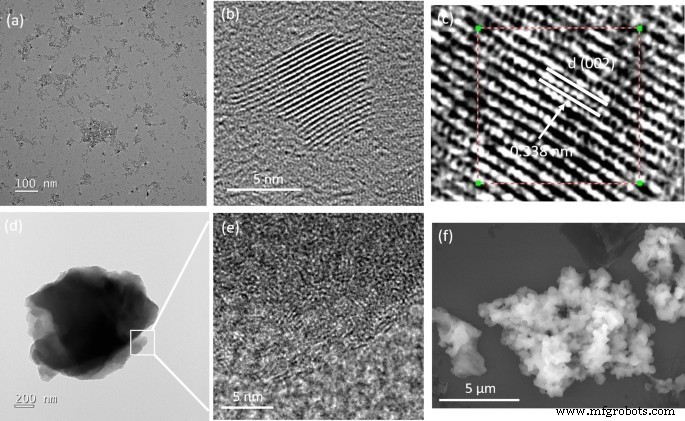
Mikrograf elektron transmisi (TEM) dan mikrograf elektron pemindaian (SEM) dari BGH dan BMH yang telah disiapkan diendapkan dari larutan etanol encer. a , b TEM pembesaran tinggi dan rendah dari BGH, c TEM BGH resolusi tinggi dengan jarak kisi (002) yang berbeda sebesar 0,338 nm, d Gambar TEM perwakilan BMH pada perbesaran rendah, e gambar TEM yang diperluas dari area kotak di Gbr. 1d menunjukkan fitur distorsi struktural dalam oksida graphene berlapis, dan f citra SEM representatif dari BMH
Gambar 2 menunjukkan pola XRD BMH03 (jejak hijau), BMH01 (jejak merah), dan BGH01 (jejak biru) yang disiapkan di laboratorium kami pada kondisi reaksi yang ditentukan seperti yang tercantum dalam Tabel 1. BGH01 menunjukkan puncak difraksi luas yang berpusat di sekitar 26,6° dan 43,1° (2θ), yang merupakan pola difraksi khas dari boron nitrida turbostratik (t-BN). Puncak lebar yang berpusat pada sekitar 26,6° berasal dari bidang pantul (002), dan puncak lebar 43,1° sesuai dengan bidang pantul (10) yang diinduksi oleh boron nitrida heksagonal (h-BN) [37]. Pola XRD BMH didominasi oleh dua pola difraksi luas pada 2θ sekitar 25,4° dan 42,4°, yang merupakan pola tanda tangan untuk pita (002) dan (10), masing-masing dari struktur kristal heksagonal grafit [38]. Pita (10) yang biasa dilambangkan juga dikaitkan dengan refleksi 2D karbon turbostratik [39]. Selain itu, tidak adanya puncak pada 2θ sekitar 10,9° dan munculnya pita lebar pada sekitar25,4° disebabkan oleh penggabungan dopan atau pengotor dalam struktur grafena atau grafit oksida [40,41,42,43, 44,45]. Oleh karena itu, masuk akal untuk mengusulkan bahwa struktur dominan BMH adalah oksida graphene yang didoping.
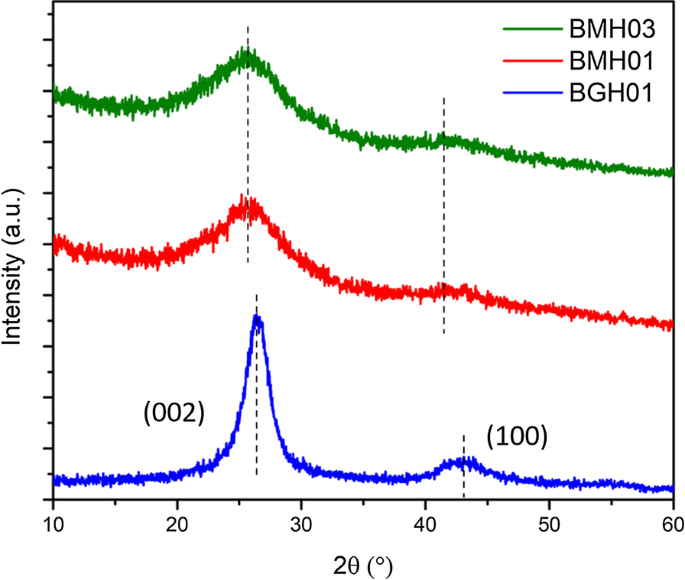
Pola XRD polikristalin BMH03 (jejak hijau), BMH01 (jejak merah), BGH01 (jejak biru), dan BGH01. Puncak lebar seri BGH01 di ca. 26,6° mewakili pantulan bidang (002) dari h-BN dan puncak lebar lainnya di ca. 43,1° mewakili bidang refleksi yang belum terselesaikan dari h-BN. Pola difraksi BMH menunjukkan dua pemantulan luas yang berpusat di sekitar ~ 25.4° dan ~ 42.4°. Pola XRD dari seri BCNO lainnya ditunjukkan di File tambahan 1:Gambar S3)
Spektroskopi XPS, FTIR, dan NMR solid-state dilakukan untuk menghasilkan pemahaman yang lebih mendalam tentang struktur molekul BGH. XPS digunakan untuk mengonfirmasi keberadaan elektron tingkat inti dari elemen B, C, N dan O dan ikatan kimianya masing-masing dalam senyawa BGH. Gambar 3a–e menunjukkan spektrum XPS tipikal dari nanodisk BGH. Menurut analisis komposisi unsur permukaan XPS, BGH mengandung kandungan B dan N yang tinggi (masing-masing sekitar 40%), dengan komposisi C dan O yang lebih rendah, masing-masing sekitar 8% dan 13% (File tambahan 1:Tabel S3). Stoikiometri mendekati 1:1 dari komposisi B dan N sepadan dengan analisis XRD, yang menegaskan bahwa BGH01 yang disiapkan di laboratorium kami terdiri dari struktur boron nitrida turbostratik. Semua spektrum XPS dilengkapi dengan fungsi Gaussian dengan R 2 > 0,99, yang diwakili oleh kurva merah dan hijau dalam spektrum XPS untuk setiap elemen. Untuk seri BGH, B1s spektrum didekonvolusi menjadi dua kurva yang sesuai, yang berhubungan dengan ikatan B-O (pada energi ikat 189,7 eV) dan ikatan B-N (pada energi ikat 190,7 eV). N1s spektrum dilengkapi dengan dua kurva Gaussian yang terdiri dari ikatan N-B dengan energi ikat 397,3 eV dan ikatan B-N–O dengan energi ikat 398 eV [46]. Ikatan N-B dan B-N-O menunjukkan adanya hBN yang didoping-O atau pembentukan senyawa BNO [47]. Karena sintesis BGH dilakukan di bawah kondisi atmosfer, atom oksigen juga dimasukkan ke dalam domain h-BN untuk ikatan B-O seperti yang dilaporkan dalam literatur [47]. Hipotesis ini dikonfirmasi dengan menganalisis O1s spektrum, yang menunjukkan puncak tunggal yang sesuai dengan ikatan B-O (energi ikat pada 532 eV). Hasil ini semakin mendukung hipotesis awal kami bahwa seri BGH tersusun dari hBN yang didoping-O, dan sebagian besar atom oksigen terikat pada atom boron. C1s spektrum BGH didekonvolusi menjadi tiga spesies C, yaitu C-O, C-B, dan C–O–C, yang masing-masing terikat pada 283,7 eV, 285 eV, dan 287 eV. Karena komposisi C yang rendah dan stoikiometri B dan N 1:1 dalam seri BGH, kami selanjutnya berspekulasi bahwa struktur BGH01 adalah h-BN yang didoping C dan O. Struktur yang diusulkan didukung oleh pembentukan ikatan C-B, B-O, dan B-N-O dalam domain hBN, sebagaimana dibuktikan dalam spektrum XPS (Gbr. 3). Oleh karena itu, masuk akal untuk menyimpulkan struktur nanodisk BGH yang disiapkan pada 800 °C sebagai hBN yang didoping-C dan O. Selanjutnya, bubuk XRD dan TEM resolusi tinggi mendukung pembentukan ikatan kovalen B, C, N, dan O dalam kisi sarang lebah dengan jarak kisi yang mirip dengan boron nitrida turbostratik. Sepanjang naskah ini, struktur BGH01 akan disebut sebagai hBN yang didoping BCNO.
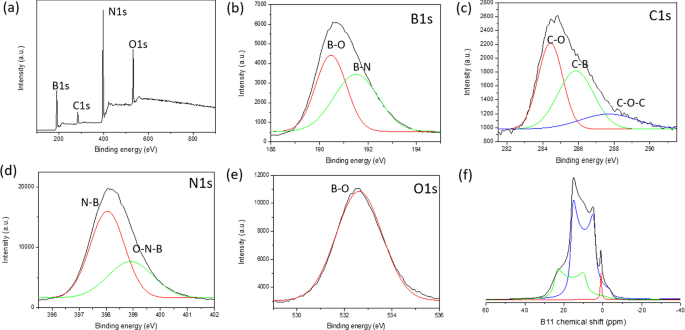
a Spektrum survei XPS BGH01. Spektrum tingkat inti b B1s , c C1s , d N1s , dan e O1s . Setiap puncak terdekonvolusi dilengkapi dengan fungsi Gaussian. f 11 B spektrum MAS NMR solid-state dari BGH01. ( 11 B solid-state MAS NMR dari BGH01-LT ditunjukkan pada File tambahan 1:Gambar S10)
Kami juga menyelidiki pengaruh suhu dan waktu kalsinasi pada aktivitas struktur-fotokatalitik struktur nano BCNO sambil menjaga parameter sintesis lainnya konstan. Dengan meningkatnya suhu reaksi (dari 600 °C ke 800 °C) dan peningkatan waktu reaksi dari 30 menit menjadi 12 jam, terjadi peningkatan keseluruhan dalam ikatan B-N dan B-O (File tambahan 1:Gambar S6). Sebaliknya, ikatan B-C menurun dengan meningkatnya suhu dan waktu reaksi, yang menyiratkan pembentukan ikatan B-N dan B-O heksagonal yang stabil secara energetik sambil mengorbankan ikatan B-C yang metastabil [48]. Seperti yang diantisipasi, komposisi ikatan B-C meningkat dengan meningkatnya rasio prekursor heksametilenatetramina (sebagai sumber C) sambil menjaga parameter lainnya konstan [49]. Tren yang lebih mendetail dari evolusi ikatan kimia BGH yang disiapkan pada suhu, waktu, dan rasio prekursor yang berbeda tersedia di ESI (File tambahan 1:Gambar. S6 dan S7).
1 11 NMR MAS solid-state B digunakan untuk menganalisis secara kuantitatif setiap komposisi ikatan terkait-B dalam BGH dan BMH secara kuantitatif. Di sini, kami menyajikan karakterisasi struktural terperinci pertama BCNO pada tingkat molekuler menggunakan MAS keadaan padat 13 C dan 11 B NMR untuk mengumpulkan ikatan spesifik terkait C dan B. Meskipun nanomaterial hBN dan sifat elektronik yang diinduksi cacat telah menarik minat yang signifikan, struktur molekul tepi hBN dan struktur cacat sebagian besar tidak diketahui [50]. Kurangnya karakterisasi struktural bahan nano terkait boron disebabkan oleh kesulitan dalam menganalisis keadaan padat 11 Spektrum B NMR karena 11 B adalah inti segi empat setengah bilangan bulat (I = 3/2) [51, 52]. Kondisi padat 11 B NMR juga menantang untuk ditafsirkan karena kopling kuadrupol orde kedua menghasilkan distorsi sinyal, yang hanya dapat dirata-ratakan sebagian melalui MAS NMR [53]. Selanjutnya, kisaran pergeseran kimia untuk 11 B NMR relatif sempit, membuat penetapan puncak dari puncak yang luas, tumpang tindih, dan terdistorsi dari berbagai spesies boron sangat menantang [54]. Dalam penelitian ini, kami melakukan 11 NMR solid-state B direkam pada 9,4 T, dan spektrum didekonvolusi menggunakan analisis bentuk garis padat (SOLA) topspin. Dengan mengikuti CP-MAS 11 Eksperimen B NMR yang dilaporkan dalam literatur, kami memperoleh informasi ikatan kimia terkait B yang bermakna dengan mempertimbangkan konstanta kopling kuadrupolar (C T ) dan asimetri tensor gradien medan listrik (EFG) (η T ) [51, 52, 55]. Gambar 3f menunjukkan keadaan padat 11 B spin-echo NMR spektrum BGH dengan tiga puncak utama dan δ iso berpusat pada 28,3 ppm, 20 ppm, dan 1,2 ppm, masing-masing. Berdasarkan studi literatur tentang CP-MAS 11 B NMR boron nitrida dan struktur terkaitnya, puncaknya dengan δ iso dari 28,3 ppm (kesesuaian jejak hijau) dan C T dari 2,85 MHz sesuai dengan BN trigonal-planar2 (OH) spesies dengan gugus hidroksil tunggal [53,54,55]. Ketika gugus hidroksil atau atom penghubung oksigen menggantikan atom nitrogen di sekitar situs boron trigonal-planar, spesies B baru dengan δ iso dari 20 ppm (trace fit biru) muncul. Sinyal pergeseran kimia yang lebih rendah ini kemungkinan besar dikaitkan dengan situs boron trigonal lain dengan dua gugus hidroksil atau satu gugus hidroksil dan satu atom oksigen penghubung (BN(OH)2 atau situs BNO(OH)). Puncak yang tajam di δ iso 1,2 ppm (kesesuaian jejak merah) sesuai dengan situs B tetrahedral empat koordinat, kemungkinan dikoordinasikan oleh nitrogen dan beberapa gugus hidroksil atau atom oksigen penghubung (52–54) atau ikatan C-B terkait karbon [46, 52]. CP-MAS 11 Analisis B NMR dari BGH01 mengungkapkan berbagai ikatan B-N, O-B, dan B-C yang sepadan dengan analisis XPS dan XRD. Selanjutnya, solid-state 11 B NMR juga mengungkapkan bahwa sebagian besar boron terikat dengan nitrogen dan dengan satu atau lebih gugus hidroksil sebagai BNx (OH)3−x jenis. Spesies terhidroksilasi ini dispekulasikan untuk memberikan stabilitas koloid dalam larutan berair melalui ikatan hidrogen dan stabilisasi elektrostatik. Kami juga mengamati pengurangan spesies B tetrakoordinat seperti BNx (OH)4−x atau BNx (O)(OH)3−x (di mana O adalah oksigen penghubung) dan cincin boroxol [54, 56] dengan meningkatnya suhu reaksi. Secara bersamaan, berbagai trikoordinat BNx (OH)3−x spesies muncul ketika suhu anil meningkat dari 600 °C menjadi 800 °C (File tambahan 1:Gambar S8 dan S10). Hasil ini menyiratkan bahwa pada suhu tinggi, cincin boroksol bereaksi dengan amonia untuk membentuk berbagai BN terhidroksilasix (OH)3−x atau BNx (O)(OH)2−x spesies [55] (File tambahan 1:Gbr. S10).
Berdasarkan analisis struktural kami yang kuat melalui XPS dan FTIR serta 11 B, dan 13 C MAS NMR solid-state, struktur BMH diusulkan sebagai oksida graphene yang didoping BCNO. Menurut analisis elemen permukaan XPS, BMH terdiri dari 75% spesies karbon dan hanya 5% spesies terkait boron (File tambahan 1:Tabel S3). B1s yang terdekonvolusi spektrum menunjukkan ikatan BCN dan BN masing-masing pada energi ikat 191,7 dan 192,4 eV (Gbr. 4). C1s spesies menunjukkan dua sinyal emisi foto yang berbeda, yang berhubungan dengan ikatan C–C (sp 2 dan sp 3 ikatan C–C) dengan energi ikat pada kira-kira 285,0 eV, dan komponen yang lebih lemah muncul dari ikatan B-C-N yang muncul pada 285,6 eV [57]. Sinyal lain yang relatif kecil pada 288,0 eV dan 288,7 eV disebabkan oleh C-N3 dan ikatan C = O, masing-masing [46, 57, 58]. Atom C teroksigenasi (C = O) diperkirakan terbentuk di tepi domain oksida graphene, dan C-N3 ikatan adalah puncak karakteristik untuk CN. N1s Spektrum XPS, berpusat pada energi ikat 399,0 eV, dapat dilengkapi dengan dua kurva Gaussian yang terdiri dari C-N-B pada pengikatan 399,2 eV dan ikatan C = N pada 400,0 eV [46, 57, 59, 60]. Berdasarkan analisis XPS, seri BMH hanya terdiri dari sekitar 10–25% ikatan terkait-O dibandingkan dengan sekitar 35% ikatan terkait-O dalam seri BGH. O1s spektrum yang berpusat pada 531,2 energi ikat eV dapat didekonvolusi menjadi ikatan C = O dan CO, yang dapat dikaitkan dengan domain oksida graphene. 13 C solid-state CP-MAS NMR lebih lanjut menunjukkan adanya ikatan C = C grafit pada 40,2 ppm, yang dikuatkan dengan hasil XRD dan XPS [38] (Gbr. 5). Dalam setiap seri BMH yang dilaporkan dalam makalah ini, 13 C NMR menunjukkan dua rasio equimolar spesies karbon pada 160 dan 154 ppm sesuai dengan C α dan C β , respectively, which is typically found in graphitic carbon nitride structures [61] (Fig. 5 and Additional file 1:Table S4). Compared to the bulk CN synthesized according to the literature procedure [34], the chemical shift of the signature resonance for C α and C β peak appeared at 164 and 156 ppm, respectively (Fig. S13). Boron doping into the CN heptazine structure could have contributed to these slight chemical shift differences between the BMH series and the bulk CN (Additional file 1:Fig. S13).
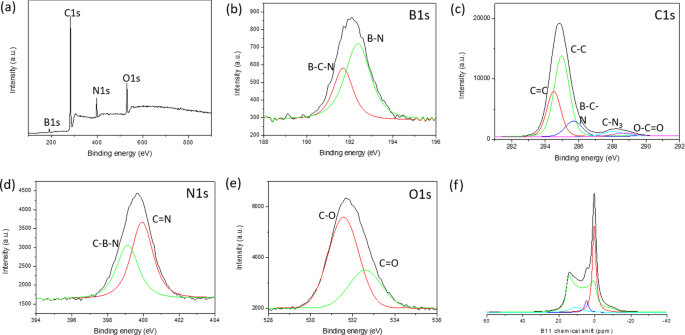
a Survey XPS spectra of BMH01 and 11 B NMR spectra. Core level spectra of b B1s , c C1s , d N1s , and e O1s . Each core spectra were fitted with a black trace, while the red and green traces under the peak were deconvoluted using a Gaussian function. f 11 B solid-state MAS NMR were deconvoluted using SOLA analysis to tricoordinate and tetracoordinate B-sites. The XPS and 11 B solid-state MAS NMR of other BMH series compounds can be found in Additional file 1:Figure S7, S11, and S12)
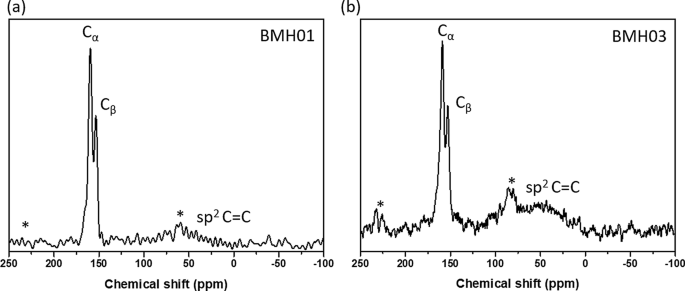
Solid-state 13 C MAS NMR of a BMH01 and b BMH03
Due to the abundant evidence of the presence of carbon nitride (CN) in the BMH series based on solid-state NMR spectroscopy (Fig. 5), we considered three possibilities of interactions between BCNO-doped graphene oxide and CN in BMH, namely:(i) bulk phase separation, (ii) disordered 2D network, and (iii) layered intercalation [62]. To eliminate the possibility of bulk phase separation, we examined the XRD pattern of CN nitride andBMH as well as a physical mixture of both in a 1:1 mass ratio. We found that the XRD patterns of the mixtures showed only the diffraction pattern of the bulk CN with a slight reduction in the crystallinity compared to the pristine CN diffraction [63] (Additional file 1:Fig S4). Since the XRD pattern of BMH did not possess any diffraction peaks that corresponded to CN, this experimental result confirmed that CN did not form as a bulk-separated domain during the synthesis of BMH (Additional file 1:Fig. S4). We also considered the formation of a disordered 2D network, in which CN and the doped-graphene oxides are bonded on the same 2D plane [62]. Based on a literature report on a CN/graphene oxide 2D matrix, the XRD pattern of a disordered 2D network showed characteristic peaks for both species with a slight peak broadening and a slight peak shifting [64]. However, the XRD pattern of BMH (Fig. 2) did not contain any signature diffractions of CN. A previous study also showed that characteristic peaks of graphene oxide disappeared in a graphitic CN/amorphous CN/graphene oxide composite due to the layer-by-layer interactions [65]. Therefore, it is reasonable to propose that CN is intercalated between the doped-graphene oxide layers. The FTIR spectrum of the selected BGH and BMH series is shown in Additional file 1:Fig. S5.
Boron-related bonding within the BMH series was investigated using 11 B solid-state MAS NMR at 9.4T, and the broad NMR spectrum was deconvoluted using the SOLA analysis showing the presence of both tricoordinate and tetracoordinate boron site. The SOLA analysis yielded four line fittings under the broad 11 B NMR spectrum, which could be assigned as trigonal planar BN2 (OH) or BN2 O at a δiso of 19.8 ppm and a CQ of 2.85 MHz (green fitting). The bay and corner B sites as in B-doped CN appeared at a δ iso of 5 ppm and δ iso of 11 ppm, respectively [61]. These assignments are also commensurate with the formation of CN based on the 13 C NMR and XPS analyses. Compared to the BGH series, the relative composition of the tetracoordinate B(IV) site of BMH was much higher (ca. 55% in the BMH series vs. 3% in the BGH series). However, the tetracoordinate B(IV) species in BMH appeared at a lower chemical shift than those found in BGH (Fig. 3f) and was therefore presumed to be the BN2 (OC)2−x (OH)x species [46]. Notably, the h-BN domain was absent from the BMH series prepared via thermal annealing at a lower temperature (600 °C). However, upon increasing the thermal annealing temperature from 600 °C to 800 °C, the structures of BMH01HT-30 min and BMH01HT-12 h showed a high composition of tetracoordinate BN2 (OH)2 species and the tricoordinate BN3 bonding (Additional file 1:Fig. S11 and S12). The presence of a high composition of tetracoordinate BN2 (OH)2 and BN3 bonding was shared among all the inactive BCNO investigated in this study. Moreover, although BMH01HT-12 h possessed an identical surface elemental composition to that of BGH01, the solid-state 11 B NMR revealed that both compounds possessed significant structural differences, which explained for their differences in photocatalytic activity (Additional file 1:Table S3 and Fig. S12).
In light of the moderate photocatalytic activity of BMH01 and BGH01 (Fig. 7), further synthesis optimization was performed to expand their light absorption spectrum into the visible light region. Previous literature showed that increasing the composition of the hexamethylenetetramine precursor (as a carbon source) could modulate the bandgap and photoluminescence properties of BCNO. Based on these reports, BMH and BGH compounds with a higher ratio of hexamethylenetetramine were prepared accordingly while keeping the other parameters constant. The optimized BCNO with a higher carbon content is denoted as BMH03 and BGH03, in which the molar ratio of carbon source was increased from 0.1 to 0.3. The higher ratio of hexamethylenetetramine precursor yielded BMH03 with a higher composition of the graphitic domain as in sp 2 C = C, and a small peak emerged which corresponded to BCN bonding at 191 eV binding energy (Additional file 1:Fig. S7). The increase in the graphitic sp 2 C = C domain upon increasing the concentration of hexamethylenetetramine is consistent with the role of hexamethylenetetramine as both a C and N source in the synthesis of N-doped graphite [66]. The increased sp 2 C = C graphite bonding in BMH03 was further confirmed via 13 C CP-MAS NMR with the emergence of a more prominent peak centered at 40.2 ppm, which is the signature of graphitic C = C(H) bonding (Additional file 1:Table S4).
The optical properties of BMH and BGH were investigated using UV–visible absorption and photoluminescence spectroscopy, as shown in Fig. 6. Since BGH and BMH series possessed distinctively different structures, and the optical properties of nanomaterials are highly correlated with their structures, the origin of absorption and luminescence for both series were also found to be different. In this study, BGH01 quasi-spherical nanoparticles showed a featureless UV–vis spectrum. (Fig. 6a, red trace). As the ratio of hexamethylenetetramine increased, the intensity of absorbance peaked at 237 nm for BGH03 and increased with the emergence of an additional broad absorption peak centered around 330 nm (Fig. 6a, blue trace). The origin of the optical properties of BCNO is controversial due to the lack of structural analysis of BCNO nanomaterials. The most widely cited origin of photoluminescence of BCNO is attributed to the formation of B, C, N, and O self-interstitial sites, substitutional impurities, and native point defects within hBN or the graphene matrix [50, 67, 68]. Other possible photoluminescence mechanisms in the BCNO system include the electronic transition from the nitrogen-vacancy (VN ) levels to the carbon impurity levels, the electronic transition between the closed-shell BO − and BO 2− anions, and intrinsic state emission and defect state emission (surface energy traps). The featureless UV absorbance of BGH01 can be attributed to the electronic transition between the valence band (VB) and conduction band (CB) of boron nitride with a bandgap energy of ca. 5.9 eV. The lower energy absorption in BGH03 was a result of the mid-gap absorption from the valence band to the nitrogen-vacancy (VN ) level located approximately 0.7–1.0 eV below the conduction band of hBN.(62) The absorption peak at ca. 330 nm could be attributed to the presence of C-related impurities level located ca. 2–4 eV below the conduction band of hBN [69,70,71]. Under 365 nm excitation, BGH01 produced a broad emission with three bumps located at 412 nm, 445 nm, and 489 nm, respectively. Based on the BGH structural analysis, in which the dominant structure was composed of BN and BO-related bonding, the photoluminescence of the BGH series could be most likely originated from the B-O luminescence centers [24, 47, 72]. The yellow-green emission at 445 and 489 nm could be induced by the transition from the VN level to the carbon-related and oxygen defect levels (2–4 eV) below the conduction band of h-BN [69,70,71]. As the C composition increased in BGH03, the emission wavelength was further red-shifted to 506 nm, consistent with literature reports [73, 74]. The stacked photoluminescence (PL), UV absorbance, and Tauc plot for different BGH series prepared in this study are presented in Additional file 1:Fig. S14.
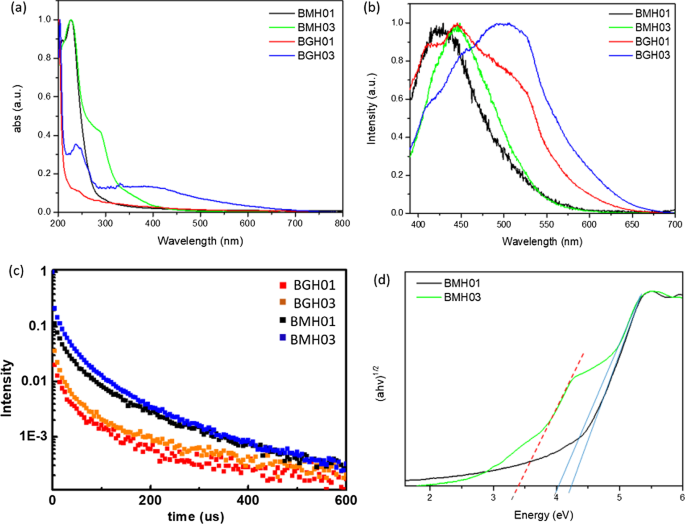
a Overlay UV absorbance spectra of BMH01, BMH03, BGH01, and BGH03. b Stacked photoluminescence spectra of BMH01, BMH03, BGH01, and BGH03 upon excitation at 365 nm c stacked photoluminescence lifetime decay spectrum of BMH01, BMH03, BGH01, and BGH03 monitored at a predetermined λ max for each sample. Samples were excited with 337 nm laser pulses at 298 K, d Overlay Tauc plot (αhv) 1/2 vs. hv, for BMH01 (black trace) and BMH03 (green trace). The optical band gap is represented by thesolid line, while the interband state for BMH03 is represented by the red dashed line
Based on XRD and various spectroscopic analyses, the structure of BMH was deduced to be dominated by BCNO-doped graphene oxides (Fig. 4, Additional file 1:Fig. S7, and Fig. S12, and Table S4). Thus, the optical properties of the BMH series are hypothesized to be more closely related to the carbon-quantum dot (CD) [75, 76] and doped-graphene oxides systems [44, 77,78,79]. Based on the origin of photoluminescence of the CD and graphene oxides, the optical properties of BMH prepared in this study can be attributed to the intrinsic state emission [76, 80, 81], electron–hole recombination [82, 83], and defective state emission [84]. Intrinsic emission of BMH is speculated to have originated from isolated sp 2 luminescence centers embedded within the sp 3 matrix of the carbonaceous film. The sp 3 matrix of graphene oxides is composed of C–OH, C–O–C, and C = O edge sites, whose energy levels lie between the energy levels of π–π* states of the sp 2 C = C domain, thus giving rise to multiple absorption bands. Both BMH01 and BMH03 possessed a strong UV absorbance band at ca. 240 nm, corresponding to the π to π* transition of C = C within the graphene oxides domain. With the increasing ratio of hexamethylenetetramine in the BMH03 sample, an additional bump at 288 nm emerged, which can be ascribed to the n-π* transition of the C = O and C = N bonds of the oxidized graphitic region [77, 85, 86]. The latter absorbance band at ca. 288 nm was induced by oxygen, nitrogen, and boron defect sites, creating new radiative recombination sites [82, 87,88,89]. Upon photoexcitation at 365 nm, BMH01 and BMH03 exhibited a maximum emission wavelengths at 429 and 447 nm, respectively. The BMH03 sample showed a slight red-shift emission, unlike BMH01 due to the greater extent of graphitization [77, 84] (Additional file 1:Figs. 5 and 6). Both BMH samples revealed a broad and much lower energy emission wavelengths than BGH samples due to lower energy emissive centers arising from O, N, and B defects and surface states. According to the electron–hole recombination mechanism, these photoexcited electrons from each defect state recombine with their corresponding holes in the HOMO, thus yielding a broad photoluminescence emission [90] (Fig. 6b). Interestingly, only BMH01 exhibited a pronounced excitation-dependent photoluminescence as observed in other BCNO [72] and carbon quantum dot systems [76]. The presence of O, and N impurities embedded within the graphene oxides matrix was shown to create a large number of surface emissive traps that corresponded to a diverse energy levels within the bandgap, thus yielding an excitation dependent fluorescence spectra in BMH01 (Additional file 1:Fig. S15). In contrast, the lack of an excitation dependent emission in BMH03 could be explained by the formation of a greater extent of graphitization (C = C) with a concurrent reduction in the surface states population (eg.:C = O) [44].
The bandgap values of BMH and BGH prepared in this study were estimated from Tauc's formulation:(αhν) 2 − hν, where α is the absorbance (Fig. 6d). The bandgap was estimated by extrapolating the photon energy intercept at (αhν) 2 = 0. For the BMH series, the presence of multiple energy levels within the optical bandgap may have originated from the electronic transition from various π-π* (C = C bonds) and n-π* of C = O or other surface groups [76, 82, 87]. As for the BGH series, carbon substituted on boron sites (CB ), nitrogen-vacancy sites (VN ), and interstitial carbon defect levels gave rise to the emergence of interband states between the bandgap of hBN. The presence of multiple energy levels was supported by the photoluminescence spectra of lower energy radiative recombinations [24, 47, 66] (Fig. 6b and Table 2). The BGH03 sample exhibited two large bandgaps at 5.7 eV and 3.8 eV, corresponding to the bandgap of hBN and the transition from the valence band to VN levels, respectively [50, 74] (Additional file 1:Fig. S14).
Long-lived charge carriers that can persist into the microseconds and milliseconds timescales in semiconductor photoelectrodes such as CN photocatalysts, have been proposed as an important parameter in enhancing photocatalytic activity by reducing charge recombinations [91,92,93,94,95]. Time-resolved photoluminescence (TRPL) experiments were conducted to gain insight into the recombination processes of the photogenerated charge carriers of BCNO (Fig. 6c). The µs-PL decay kinetics could be fitted with three exponential decays according to the following equation.
$$I\left( t \right) =I_{1} \exp ( - t/\tau_{1} ) + I_{2} \exp ( - t/\tau_{2} ) + I_{3} \exp \left( {t/\tau_{3} } \right)$$The multiple exponential decays imply that BCNO undergoes complex recombination from both intrinsic and defect states of BCNO [32, 72]. In the equation, I 1 through I 3 are constants with values of emission intensity measured at t =0, andτ 1 through τ 3 are the lifetimes of three channels responsible for the decay, respectively. Through multiexponential fitting of the entire decay curves for the BMH and BGH series, the average lifetimes were calculated to be 1.58, 2.10, 5.18, and 8.14 µs for BGH01, BGH03, BMH01, and BMH03, respectively. The values of I and τ in Eq. 1 for the BMH and BGH series are reported in Additional file 1:Table S5. The persistent lifetime of the charge carrier in the BCNO system has been attributed to the presence of shallow traps composed of nitrogen-vacancy (VN ) stabilized by carbon impurities, which were located ca. 0.7 eV-1.0 eV below the conduction band of h-BN [72, 74]. Shallow traps in CN photocatalysts have been attributed to charge separation states with long life-times due to chemical defects [95]. According to works related to prolonged photoluminescence in CN and other nanostructured photoelectrodes [91, 92], the microseconds lifetimes of BCNO-doped graphene oxides and BCNO-doped hBN are associated with the enhanced charged separation within the BCNO domain. The ultralong lifetimes are speculated to be a critical factor in facilitating heterogeneous photocatalysis [91].
As a proof of concept demonstration, the photocatalytic performance of BMH and BGH was evaluated by the photodegradation of methylene blue (MB) under UV–visible light irradiation. Details of the experimental procedure and analysis of the photocatalytic dye degradation are available in the ESI. Figure 7 shows the percent degradation (C /C 0 × 100%) for BMH03 (red line), BMH01 (blue line), BGH01 (green line), BGH03 (orange line), and CN (purple line), where C is the concentration of MB at a time, t and C 0 is the initial concentration MB after the dark equilibrium. According to the Langmuir–Hinshelwood model, ln(C /C 0 ) = kt , where k is the rate constant, the dye degradation rate constant values were calculated to be 2.31 × 10 −3 min −1 for BMH03, 1.52 × 10 −3 min −1 for BGH01, 1.48 × 10 −3 min −1 for BMH01 and 9.38 × 10 −4 min −1 for BGH03. Compared to the state-of-the-art metal-free photocatalyst, BMH03 exhibited a 25% improvement in the photocatalytic dye degradation rates (Fig. 7). This proof-of-concept demonstration warrants a more in-depth investigation of the structure–property relationship of this new metal-free, boron-based photocatalyst.
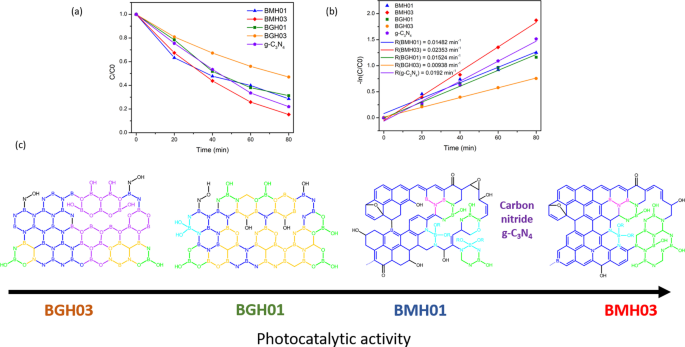
UV–visible light-induced photocatalytic MB degradation using BGH and BMH. a Photodegradation of MB under UV–visible light (plot of C /C 0 ) and b pseudo-first-order rate reaction kinetics for MB dye using BGH, BMH, and CN as a photocatalyst. c The proposed structures for BGH01, BGH03, BMH01, and BMH03 and their corresponding activities toward photodegradation of MB dye. Each domain is color-coded, i.e., BCNO (orange), h-BN and graphene oxides (blue), tricoordinate boron BN2 (OH) and BO2 (OH) (green), boroxol ring (purple), tetracoordinate B sites (aqua blue), and functional groups or dangling bonds (black).
Based on the detailed structural analysis and the proposed structure in Fig. 7c, the highest photocatalytic activity of BMH03 consisted of BCNO-doped graphene oxides [1, 65]. This ternary metal-free photocatalyst is reported to enhance the photocatalytic performances by increasing the charge separation and migration to the reaction site [1]. Additionally, the incorporation of boron into graphene-based materials [11, 20], CN [21, 96], and carbon nanotubes [97] has also exhibited enhanced performance compared to their pristine material without a dopant due to multiple synergistic effects. The large differences in electronegativity between boron, carbon, and nitrogen (2.04 vs. 2.55 vs. 3.04, respectively) yielded a strongly polarized bonding towards C and N atoms. As a result, a local positive charge was formed on boron that turned boron into a strong acidic defect site for preferential adsorption sites of pollutants [98], O2 [97], HOO
−
and OH
−
[99, 100]. Therefore, electron-rich pollutants such as MB (used as a model reaction) were speculated to preferentially adsorbed onto the electropositive B sites of the BMH photocatalyst. The photocatalytic degradation of MB on BCNO was proposed to undergo an indirect dye degradation mechanism [101]. In the indirect photodegradation mechanism, the photogenerated holes on the surface of BCNO produced highly oxidative hydroxyl radicals and attack the  bond of MB. Meanwhile, photogenerated electrons from the conduction band of BCNO formed highly reducing superoxide radical anion O2
−
species that could directly attack MB. Figure 8 illustrates the proposed mechanism of BCNO in photocatalyzing the degradation of MB
bond of MB. Meanwhile, photogenerated electrons from the conduction band of BCNO formed highly reducing superoxide radical anion O2
−
species that could directly attack MB. Figure 8 illustrates the proposed mechanism of BCNO in photocatalyzing the degradation of MB
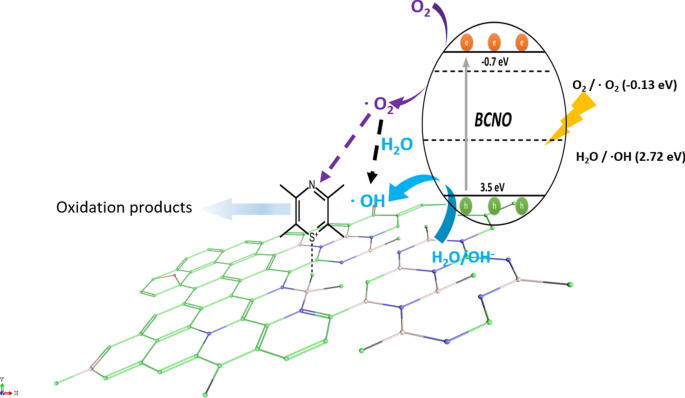
Schematic illustration of the proposed mechanism of BCNO in catalyzing the degradation of MB upon light irradiation. The positively charged MB was selectively absorbed on the N2 B-OH sites. The band structures of BMH03 were determined via UPS and Tauc plot (Fig. 6 and Additional file 1:Fig. S17). The redox potentials of O2 /O2 = − 0.13 eV vs ENHE and H2 O/OH = 2.72 eV vs. ENHE are given in black dashed lines as reference
According to the XPS and solid-state NMR analyses, BMH03 possessed a higher composition of graphitic sp 2 C = C with a simultaneous reduction in tetracoordinate B site compared to BMH01 (Additional file 1:Fig. S9 and Table S4) The high composition of tetracoordinate B-sites in BMH01 (33%) also translated to a reduction in the number of boron Lewis acid sites serving as the active catalytic center, which explains the trend of photocatalytic activities among the BMH series [13]. However, the BGH series comprised the C, and O-doped h-BN domain with various tri- and tetracoordinate boron sites. Interestingly, BGH01 annealed at a lower temperature (Table 1, BGH01LT) was found to be inactive but exhibited a high absorbing ability in removing dye from the solution (Additional file 1:Fig. S1 for TEM morphology; Fig. S16 for photodegradation MB UV–vis absorbance).
The previous report also concluded that BCNO was photocatalytically inactive towards dye degradation but exhibited an excellent absorbing ability in removing dye from the solution [102]. The inactive BGH01LT was comprised primarily of tetracoordinate B sites and boron oxides-related bonding. Based on the SOLA analysis and the literature , the tricoordinate boron site with a δ iso of 16.7 ppm was related to boroxol rings (B2 O3 ) [54, 56]. Our results are also supported by other works on the catalytic activation of peroxymonosulfate using amorphous boron [22]. However, the photocatalytic active BGH01, BMH01, and BMH03 possessed a high composition of BN(OH)2 and BN2 OH bonding sites. Our investigation suggested that the photocatalytic activity of BCNO is highly dependent on the local structure of the boron site. While the exact catalytic site and mechanism are yet to be explored, we proposed that BNx (OH)3−x served as one of the BGH and BMH series catalytic sites. For the BMH series, the formation of tetracoordinate B-O sites was detrimental in catalyzing dye degradation due to the reduction in the Lewis acid site. At the same time, the increasing composition of the sp 2 C = C graphitic domain enhanced the photocatalytic activities of the BGH and BMH series.
In summary, BCNO structures and their photocatalytic activities have been presented here and found to be highly dependent on the choice of precursor, precursor ratios, annealing temperatures, and times. In this study, two types of distinctly different BCNO nanostructures were prepared via low-temperature annealing (600 °C–800 °C):(1) BCNO-doped boron nitride and (2) BCNO-doped graphene oxides. Through systematic investigation of using two different nitrogen precursors, crystalline BCNO with a quasi-spherical shape was prepared at 800 °C for 12 hr using guanidine hydrochloride as the nitrogen source. This series of BCNO exhibited moderate photocatalytic activity through the emergence of BN2 (OH) or BN(OH)2 tricoordinate boron serving as the Lewis acidic site. However, BCNO prepared using melamine as the nitrogen source at 600 °C yielded multi-layered sheets with ill-defined shapes. These BCNO-doped graphene oxides layered structures exhibited the highest photocatalytic activity, surpassing the state-of-art metal-free photocatalyst, CN. For the melamine-derived BCNO layered structures, the presence of tricoordinate boron species as BN2 (OH) or BN(OH)2 and a higher composition of graphitic sp 2 C = C were speculated to play an important role in promoting their photocatalytic activity. This study demonstrates the potential of BCNO as a photocatalyst for energy conversion and environmental remediation applications. Further structural optimization on this new B-C-N–O photocatalyst system is expected to facilitate the development of a sustainable catalyst for applications including solar hydrogen fuel production, environmental remediation, electrocatalytic oxygen reduction reaction, and catalytic oxidative dehydrogenation reaction.
All data are fully available without restriction.
Boron carbon oxynitride
Carbon nitride
Hexagonal boron nitride
Time-resolved photoluminescence
Magic angle spin
Cross polarization
Solid line shape analysis
Intensity
Attenuated total reflectance
bahan nano
Abstrak Banyak penelitian mengungkapkan bahwa nanotube karbon berdinding banyak (MWCNTs) beracun bagi tanaman. Namun, apakah atau bagaimana MWCNT memengaruhi pembentukan akar lateral (LR), yang merupakan komponen penting dari kemampuan beradaptasi sistem akar terhadap berbagai isyarat lingkungan, m
Abstrak Pengaruh hidrogen yang didoping secara tidak sengaja pada sifat sampel p-GaN yang didoping Mg yang ditumbuhkan melalui deposisi uap kimia organik logam (MOCVD) diselidiki melalui pengukuran fotoluminesensi suhu kamar (PL) dan Hall dan spektroskopi massa ion sekunder (SIMS). Ditemukan bahwa
Deoksidasi Baja Proses pembuatan baja terdiri dari pemurnian logam panas menjadi baja yang dilakukan di bawah atmosfer pengoksidasi. Selama proses pemurnian oksigen larut dalam baja. Berikut ini adalah sumber utama oksigen dalam baja. Oksigen bertiup Penggunaan terak pengoksidasi dan bijih besi
Pelajari bagaimana komposisi kimia yang berbeda mempengaruhi baja Baja ditemukan di semua jenis produk, dari dirgantara hingga peralatan dapur. Aplikasi yang beragam seperti itu membutuhkan material yang serbaguna—dan baja sesuai dengan kebutuhan. Baja sebenarnya menggambarkan seluruh keluarga pa